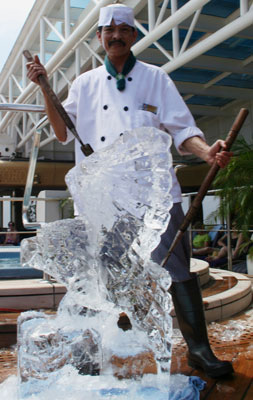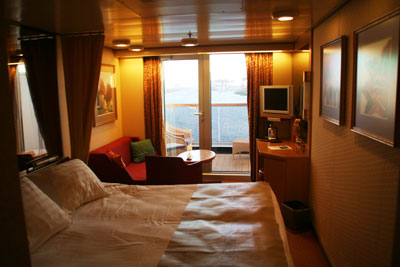Islands as easy as ABC
This item appears on page 55 of the August 2012 issue.
(First of two parts)
The “ABC islands” of the Southern Caribbean are often visited by cruise ships, but very few ships visit all three — Aruba, Bonaire and Curaçao — in one voyage. When I found out that the Noordam of Holland America Line (HAL) was sailing to all three and also to the remote Turks and Caicos Islands and the Dominican Republic, I had to go. HAL took my wife, Susan, and me as guests on this 10-day cruise, Feb. 24-March 5, 2012.
The ship’s credentials
The Noordam was built in 2006 at the Fincantieri shipyard near Venice, Italy, at a cost of $400 million. She is 935 feet long and 106 feet wide (just able to fit into the current Panama Canal locks), draws 26 feet, carries 1,848 passengers and 800 crew and has a gross tonnage of 81,769 and a maximum speed of 24 knots.
She has a bulbous underwater bow to increase her waterline length and, thus, by about fifteen percent, her speed. Instead of old-style fixed propellers, she has two modern “Azipods,” which can rotate 360 degrees, improving maneuverability dramatically and increasing engine efficiency by about six percent.
The Azipods and the large, 7,500-horsepower bow thrusters mean that the ship rarely needs help from tugs. All in all, this is a very efficient and “green” design.
The Noordam and her captain, Hans Mateboer, are well known in nautical circles for spotting and rescuing 22 shipwrecked Somali refugees who were drifting in life jackets off Kusadasi, Turkey, in 2006 after their tiny, overloaded motorboat sank.
The ship and crew were commended by her passengers (some of whom assisted in the rescue by spotting victims in the water) and were officially thanked by the UN High Commissioner for Refugees for the valiant and very competent action.
The layout
Susan and I boarded the ship in Fort Lauderdale, Florida, and inspected the public spaces. We were immediately struck by the attractive décor, the dramatic chandelier in the main atrium and the excellent sight lines in the large Vista Lounge theater.
Later we went on a backstage tour of the Vista Lounge and were impressed with the professional setup of the theater, with its very complex lighting, stage effects (background scrims, fog machine, etc.) and a stage divided into nine sections, each of which can be rapidly lowered or raised individually.
I had been a bit worried about our cabin, number 6162. It was located right at the stern, overlooking the wake, and I was afraid that we would feel some engine vibration or some pitching motion. I usually advise getting a cabin near the middle of the ship to avoid these problems.
As we pulled away from Ft. Lauderdale in the sunset, however, we felt virtually no vibration, even at maximum revolutions. And later in the voyage, when we encountered 20-foot seas for a day, we felt very little pitching or rolling. Modern ship stabilizers are a true wonder.
Our 10-by-20-foot cabin had a king-sized bed, en suite bathroom with tub and shower, a sitting area, three small closets, a small refrigerator, a flat-screen TV, a desk, a safe, an excellent view out the large glass double doors and a substantial balcony. The walls were covered with an attractive golden cloth, and the lighting was well designed for relaxing in the cabin or reading in bed.
Our fellow passengers were a pleasant mixture of Americans (about 60%), Canadians (26%), Dutch (8%) and other Europeans drawn by the unusual itinerary. There were a few children aboard, and they were kept quietly amused in the children’s play area and teenagers’ lounge. This was a rare and delightful instance of children being not seen and not heard!
Activities and meals
At every opportunity on board, we took the excellent computer classes offered by John Roberts of Microsoft in the Digital Workshop training room. John offers free and informative classes in computer security, Windows 7, camera basics, buying a computer, file sharing, social networking and photo editing plus an introduction to “the cloud.”
We took every one of the 45-minute classes, thus getting, for free, training that would have cost more than $1,000 each ashore. Every HAL ship is now equipped with a Digital Workshop, a terrific resource. Be sure to go early; every session was packed.
Other offerings on board included swimming in the two pools; tai chi; dance classes; health assessments; bicycle spinning; full spa services; acupuncture; cooking demonstrations with master chef Thomas Schumann; champagne and wine tastings; bingo; casino gambling; Broadway-style shows (including the fabulous Polish violinist Michael Bacala); lectures on the history of rum in the Caribbean immediately followed by a meeting of The Friends of Bill W., etc. Plenty to do!
The Vista Dining Room, aft, was attractive and had excellent food. Typical dishes included a terrific salad of arugula and frisée with pistachios and pine nuts; a mille-feuille of forest mushrooms (rated by my very knowledgeable wife as A+), and brioche toast with caramelized apricots and vanilla bean ice cream. This latter dish sounds odd, but it was developed by Michelin-star-winning chef Jonnie Boer in Holland, and it was very tasty.
One caution about the dining room — the aftermost 30 feet of this long space is subject to some engine noise and vibration when the ship is steaming at about 17 knots or more. Check this out and, if necessary, request a table farther forward. Any noise of talking in the room is muted by the acoustical design, which permits normal dinner conversation.
Our drink of choice is soft drinks, and these were a bit expensive on board at $2.15 each plus tax. But you can buy a card for $25 that gets you $50 worth of soft drinks, making the unit cost much more reasonable. Similar cards for wine and spirits are available, and all cards allow a refund of unused funds.
Special dining experience
On one night per cruise, the Noordam puts on a special treat: it re-creates at sea the remarkable New York restaurant Le Cirque. The modest extra cost of $39 per person is well worth it, because eating at the real NYC restaurant, a favorite of Jackie Kennedy, kings and presidents, could easily set you back hundreds of dollars.
The restaurant was founded and is still run by the legendary Sirio Maccioni, who began his career working as a waiter on the cruise liner SS Atlantic. So it was appropriate that, as a capstone of his career, he designed and installed a seagoing version of his restaurant in all the HAL ships.
According to Fabien Weichert, who worked extensively on HAL’s rollout of Le Cirque on the Noordam and in the rest of the fleet, “The concept is taken very seriously by Sirio and all the HAL staff. A number of HAL chefs studied at Le Cirque in New York, learning the recipes, the ingredients and exactly how each dish was made. The food preparation focuses on classic taste, not on molecular science and extreme presentations. Sirio, himself, and other Le Cirque staff visit the ships regularly to check on quality control.”
Passengers I spoke to praised the “wonderful” Chateaubriand steak, which can be prepared for one or two persons. Susan and I enjoyed the very smooth and flavorful butternut soup, a tasty rack of lamb with goat cheese panisse and an excellent chocolate soufflé.
For more information, contact Holland America Line (Seattle, WA; 877/932-4259).
Next month I will describe the islands we visited on this unique cruise.


